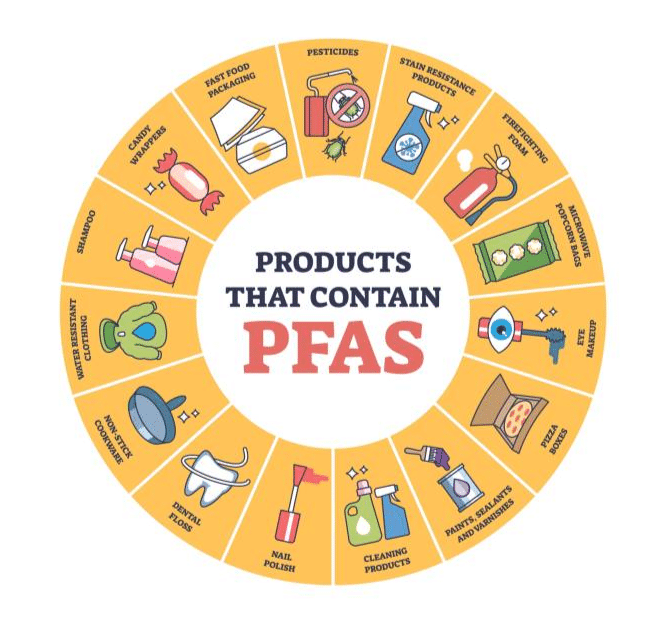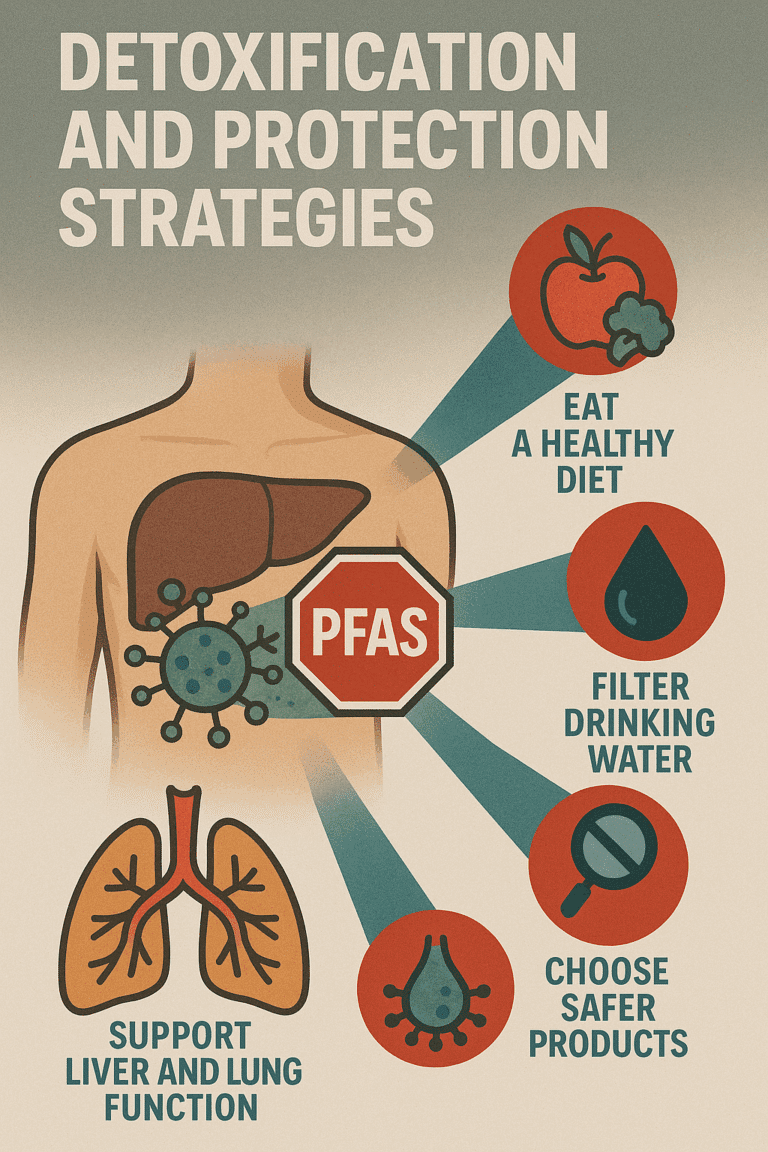PFAS chemicals, also known as ‘forever chemicals’, are not just in your kitchen, your bathroom, your closet; they’re in your bloodstream. This urgent and pervasive environmental health threat, despite its widespread use in everyday products, remains largely unnoticed by most people.
For functional medicine practitioners, PFAS represent a perfect storm of health concerns: they’re virtually indestructible, they accumulate in the body over time, and they disrupt multiple biological systems simultaneously.
Understanding what PFAS are, where they’re found, and how to minimize exposure is crucial. But it’s not just about individual action. It’s about systemic change and advocacy for anyone committed to optimal health and longevity.
What Are PFAS? The Science Behind Forever Chemicals
Per- and polyfluoroalkyl substances (PFAS) are a group of more than 9,000 synthetic chemicals that have been manufactured and used in various industries since the 1940s. They’re called “forever chemicals” because they don’t break down naturally in the environment or the human body—they persist forever.

These fluorinated compounds were engineered to be incredibly stable and resistant to heat, water, and oil. While these properties make them useful for industrial and consumer applications, they also make PFAS virtually indestructible once they enter our bodies and environment.
The most studied PFAS chemicals include:
- PFOA (Perfluorooctanoic acid)
- PFOS (Perfluorooctanesulfonic acid)
- PFNA (Perfluorononanoic acid)
- PFHxS (Perfluorohexanesulfonic acid)
Everywhere Chemicals: Where PFAS Hide in Your Daily Life
The ubiquity of PFAS is staggering. These toxic chemicals are so common in consumer products and manufacturing that they’re everywhere, including inside our bodies. Here’s where you’re most likely encountering forever chemicals:
Kitchen and Food Packaging
- Non-stick cookware (Teflon and similar coatings)
- Food packaging (pizza boxes, fast-food wrappers, microwave popcorn bags)
- Water-resistant food containers
- Coffee cups with water-resistant linings
Personal Care and Cosmetics
- Waterproof mascara and makeup
- Nail polish
- Shampoos and conditioners
- Dental floss
- Sunscreen
Clothing and Textiles
- Stain-resistant fabrics (carpets, upholstery, clothing)
- Waterproof and breathable outdoor gear
- School uniforms treated for stain resistance
Household Products
- Cleaning products
- Paint and floor wax
- Fire-fighting foam
- Paper and cardboard products
Water Sources
- Drinking water (especially near industrial sites or military bases)
- Groundwater contamination
- Municipal water supplies
The Health Impact: How PFAS Disrupt Your Body’s Systems
Recent headlines about PFAS focus on their potential health risks, and the research is deeply concerning. Studies have shown that exposure to PFAS can decrease your immunity and increase your risk of certain types of cancer, congenital disabilities, and liver and kidney disease.
Endocrine Disruption: The Hormone Connection
From a functional medicine perspective, one of the most alarming aspects of PFAS exposure is their role as endocrine-disrupting chemicals (EDCs). They act as endocrine-disrupting chemicals due to their ability to interfere with hormone systems.
Recent research has found that some PFAS can disrupt hormones such as estrogen and testosterone and impair thyroid hormone functions. A 2024 study by the Keck School of Medicine found that “exposure to a combination of PFAS not only disrupted lipid and amino acid metabolism but also altered thyroid hormone function.”
The hormone disruption caused by PFAS includes:
Thyroid Function: PFAS interfere with thyroid hormone production and transport, leading to symptoms like fatigue, weight gain, brain fog, and temperature sensitivity.
Reproductive Hormones: Studies have found evidence that suggests that forever chemicals can cause health issues, including reduced fertility and childhood development problems. PFAS exposure is associated with irregular menstrual cycles, reduced sperm quality, and pregnancy complications.
Metabolic Hormones: PFAS disrupt metabolic processes, the thyroid axis, and endocrine glands, leading to obesity and reproductive issues. This includes interference with insulin signaling and leptin (the satiety hormone).
Immune System Compromise
PFAS exposure significantly impacts immune function, making individuals more susceptible to infections and reducing vaccine effectiveness. The chemicals interfere with immune cell development and function, creating a state of chronic immune system dysfunction.
Metabolic Disruption and Weight Gain
The EPA has identified interference with the body’s natural hormones and increased cholesterol levels and/or risk of obesity as key health effects of PFAS exposure. These chemicals disrupt normal metabolic processes, making weight management extremely challenging despite dietary and lifestyle interventions.
Cancer Risk and Cellular Damage
Long-term PFAS exposure has been linked to several types of cancer, including kidney, testicular, and liver cancers. The chemicals can damage DNA and interfere with normal cell division and repair processes.
Liver and Kidney Damage
As the body’s primary detoxification organs, the liver and kidneys bear the brunt of PFAS toxicity. These organs struggle to process and eliminate these persistent chemicals, leading to organ damage over time.
Functional Medicine Approach: Root Cause and Prevention
Traditional medicine often focuses on treating symptoms after they appear. Functional medicine takes a different approach, emphasizing prevention, early detection, and addressing root causes of health issues. This approach puts you in control of your health, making PFAS awareness and mitigation crucial.
Why Functional Medicine Practitioners Are Deeply Concerned
From a functional medicine perspective, PFAS represent multiple health threats simultaneously:
- Body Burden Accumulation: Since PFAS don’t break down, they accumulate in tissues over time, creating an ever-increasing toxic load.
- Multi-System Impact: Unlike toxins that affect single organs, PFAS disrupt multiple biological systems simultaneously.
- Generational Impact: PFAS can cross the placental barrier and are found in breast milk, affecting developing children.
- Synergistic Effects: PFAS work alongside other environmental toxins to create compound health effects.
Testing and Detection: Know Your Exposure
Several tests can help detect PFAS exposure:
Blood Testing
The most accurate way to measure current PFAS levels is through specialized blood tests that can detect specific PFAS compounds. These tests are becoming more widely available through functional medicine practitioners.
Water Testing
Since drinking water is a significant exposure source, home water testing for PFAS can identify contamination levels and guide filtration decisions.
Urine Testing
While less commonly used for PFAS, some functional medicine labs offer urine tests that can detect specific PFAS metabolites.
Detoxification and Protection Strategies
While we can’t altogether avoid PFAS exposure in today’s world, you can significantly reduce your toxic burden and support our body’s natural detoxification processes.

Dietary Detox Support
Cruciferous Vegetables: Broccoli, cauliflower, Brussels sprouts, and kale contain compounds that support liver detoxification pathways.
Sulfur-Rich Foods: Garlic, onions, and eggs provide sulfur compounds essential for detoxification.
Antioxidant-Rich Foods: Berries, green tea, and colorful vegetables help combat oxidative stress from toxic exposures.
Fiber: Adequate fiber intake supports the elimination of toxins through bowel movements.
Targeted Supplements
Work with a qualified functional medicine practitioner to consider:
NAC (N-Acetyl Cysteine): Supports glutathione production, the body’s master antioxidant.
Milk Thistle: Traditionally used to support liver health and detoxification.
Activated Charcoal: Can bind certain toxins in the digestive tract (use under professional guidance).
Chlorella: This algae may help bind heavy metals and other toxins.
Lifestyle Detox Practices
Sauna Therapy: Regular infrared sauna use can support toxin elimination through sweating.
Adequate Hydration: Pure, filtered water supports kidney function and toxin elimination.
Quality Sleep: The brain’s glymphatic system clears toxins during deep sleep phases.
Stress Management: Chronic stress impairs detoxification pathways.
Practical Steps to Minimize PFAS Exposure
The practical steps you should follow:
Kitchen and Food Safety
Replace Non-Stick Cookware: Choose stainless steel, cast iron, or ceramic cookware instead of Teflon and similar non-stick surfaces.
Avoid Microwave Popcorn: Make popcorn in a covered pot with organic kernels and healthy oil.
Choose Glass or Stainless Steel Food Storage: Avoid plastic containers, especially for hot foods.
Filter Your Water: Invest in a high-quality water filtration system that removes PFAS explicitly. Reverse osmosis and activated carbon filters are most effective.
Minimize Fast Food and Takeout: Food packaging is a significant source of PFAS exposure.
Personal Care Product Swaps
Read Ingredient Labels: Avoid products containing ingredients starting with “fluoro” or “perfluoro.”
Choose Natural Alternatives: Select organic, natural personal care products when possible.
Minimize Waterproof Products: Use waterproof makeup and sunscreen only when necessary.
Clothing and Home Goods
Avoid Stain-Resistant Treatments: Choose untreated fabrics for clothing, carpets, and furniture.
Read Labels Carefully: Look for “stain-resistant,” “water-resistant,” or “anti-bacterial” claims, which often indicate PFAS treatment.
Choose Natural Fibers: Organic cotton, wool, and hemp are naturally PFAS-free.
Water and Air Quality
Install Quality Filtration: Both whole-house water filters and air purification systems can reduce PFAS exposure.
Test Your Water: Know what’s in your water supply, especially if you live near industrial areas or military bases.
Ventilate Your Home: Good ventilation reduces indoor air pollution, including PFAS from various sources.
Hope Through Knowledge and Action
While the PFAS situation may seem overwhelming, knowledge empowers action. By understanding these forever chemicals and implementing strategic changes, you can significantly reduce your exposure and support your body’s natural resilience.
The functional medicine approach recognizes that health is not just the absence of disease; it’s the presence of vitality, resilience, and optimal function. By addressing environmental toxins like PFAS alongside nutrition, lifestyle, and stress management, we can build bodies capable of thriving despite ecological challenges.
Remember, you don’t have to make every change at once. Start with the modifications that feel most manageable and gradually expand your toxin-reduction strategies. Every small step reduces your total toxic burden and moves you closer to optimal health.
The goal isn’t perfection, it’s progress. In a world where complete avoidance of environmental toxins is impossible, informed choices and strategic detox support can make a profound difference in your long-term health outcomes.
At Liveyounger, we believe health is our most valuable asset, and protecting it from forever chemicals is an investment in your future self.


